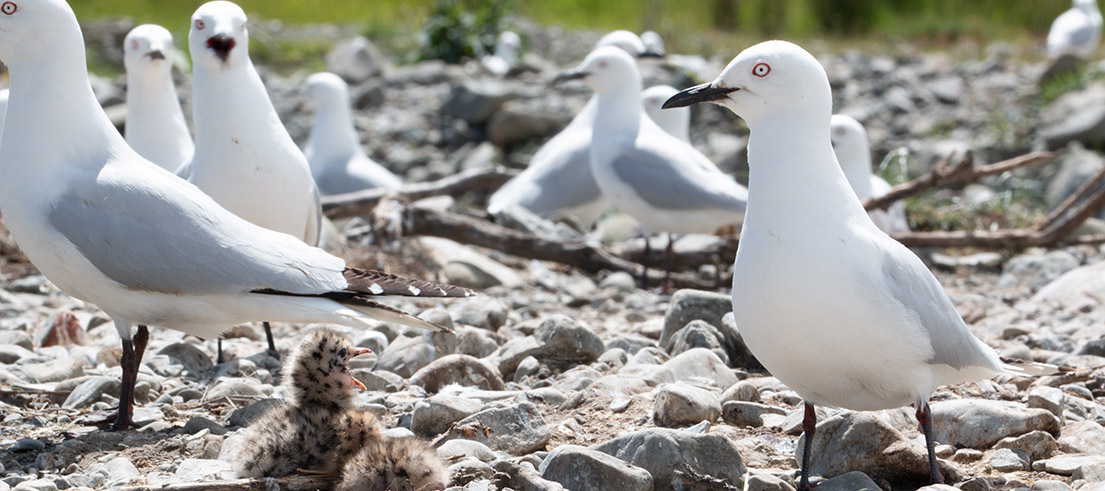
Community collaboration protects threatened gulls at the Charwell River
Classified by Te Papa Atawhai/Department of Conservation (DOC) as at risk and declining, the black-billed gull/tarāpuka is under threat of extinction. So when we were given the heads up about a colony in a North Canterbury river, we established a predator control programme in the hopes of improving their chances of breeding success.
Trapping supports breeding success
Although many of us associate gulls with the coastal environment, tarāpuka typically establish breeding colonies on braided rivers, inland lakes and, occasionally, farmland. Their preference for breeding at inland sites makes them especially vulnerable to flooding, human disturbance and mammalian predators, such as rats, weasels, ferrets, stoats and hedgehogs. They also face predation from the sky, with harrier hawks, and the heftier Southern black-backed gull/karoro, proving a major threat to ground-nesting birds such as tarāpuka.
Between September 2022 and February 2023 – the braided river bird nesting season – our Senior Biodiversity Officer Heath Melville worked with Toitū Te Whenua Land Information New Zealand (LINZ) and DOC on a trapping programme designed to support the breeding success of tarāpuka at the Charwell River site. The Kaikōura Community Shed also lent a hand, building 30 predator traps to support the work.
"We assumed the full range of mammalian predators would be there – feral cats, ferrets, stoats, weasels, rats and hedgehogs," Heath said.
"Sure enough, the 46 traps we laid caught some of everything. Even when we dialed back trap checks to monthly after the tarāpuka had left the site, we were still catching the full suite of mammalian predators, even when the bait was three-to-four-weeks old."
A win for predator control
Through fortnightly monitoring, it is estimated that at least 300 tarāpuka chicks managed to fledge from the 450 chicks surveyed at the colony's peak in early December 2022. Regardless, 24 fledglings were found dead on the road nearby, with survival rates of those that fledge particularly low in the first year of life.
"Charwell River is one of four known nesting sites for tarāpuka in the Kaikōura and Hurunui-Waiau Uwha Zones," Heath said.
"The Waiau Toa/Clarence River hāpua colony failed again this year due to the river and high seas washing the colony away. The Hurunui experienced some monitored breeding success. The Charwell looks to have had the most success in fledging tarāpuka in the north of the region."
Heath said the high count of chicks to adults suggests that the Charwell site can offer a safer breeding ground compared to other monitored sites, where flooding and predation from mammalian and avian predators are major causes of nest failure, along with human interference. Predator control can help reduce predation, potentially increasing the chance of breeding success.
"Without our intervention here, it is likely that the karoro nesting alongside them would predate the tarāpuka chicks," Heath said.
"Karoro predation has led to the complete failure of tarāpuka colonies at other Canterbury sites so it's great we've been able to work with other agencies, the Kaikōura Men's Shed, and a very helpful landowner to give the tarāpuka a better chance at breeding successfully.
"Coupled with weed control to maintain and increase suitable nesting habitat, we're hoping to increase the odds for the breeding success for tarāpuka."
The future of colony success
With the Charwell River free from the disruption of recreational access, or the challenge of high seas, Heath would like to see the Charwell River project remain a priority for North Canterbury. He encourages collaborations with DOC, LINZ and Te Rūnanga o Kaikōura to continue, alongside an increase in traps for the site, and continued focus on the control of karoro which, due to land use changes, have become super abundant and now threaten other river birds.
A weed management programme to protect the open gravel environments that our braided river birds depend on for nesting also makes Heath’s wishlist for the wider Tūtae Putaputa/Conway catchment, among other relatively weed-free sub-catchments.
"Long-term commitment by us and other agencies would greatly benefit this mahi at key sites for colony species: Waiau Toa hāpua and the rocky outcrops south, Upper Waiau Toa, Waiau Uwha and Hurunui," he said.
"Collectively, we're all responsible for taking care of tarāpuka and other braided river birds, and they need all the help that they can get to have any success in breeding in these wild, but highly modified environments."

